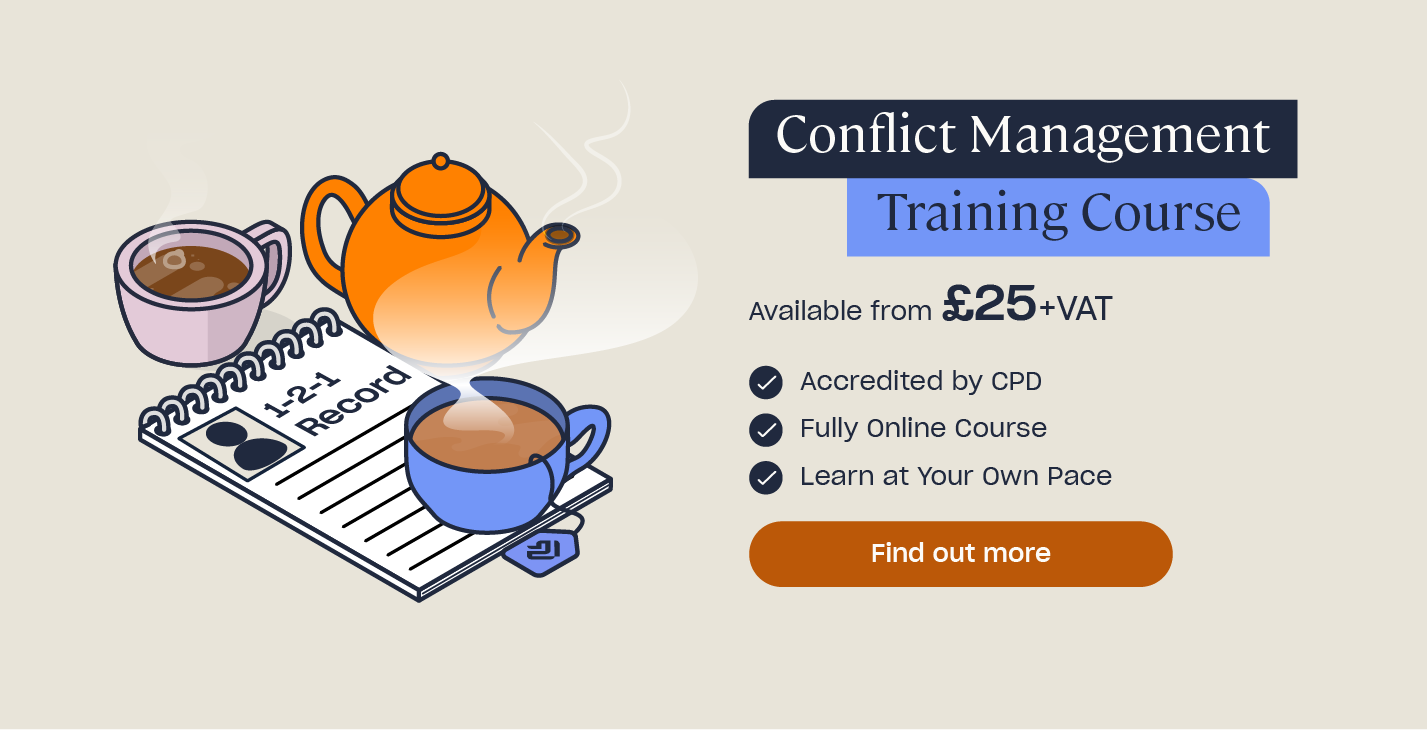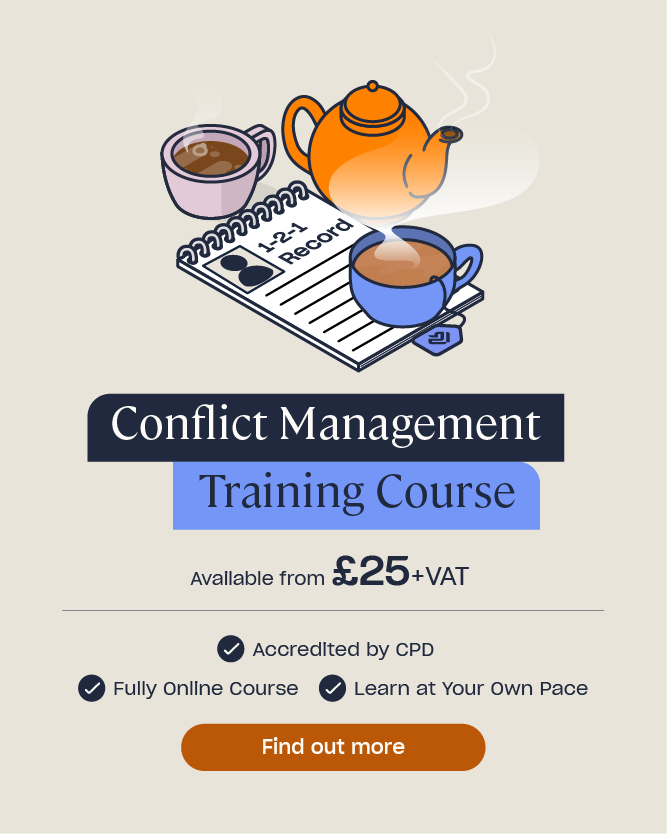Managing Conflict in the Workplace: A Guide for Line Managers
Tension between people at work is natural – in large, diverse teams it’s unlikely that everyone will always agree and share the same goals.
But an important part of teamwork is working around one another’s differences, not against them. When clashes occur, the cogs that are a company’s employees stop turning in synchronisation, which slows or halts productivity.

Effective intervention from managers and supervisors ensures that the harm conflicts cause to relationships and productivity is minimal. It keeps relationships healthy, customers happy, and the business successful.
What is Conflict Management?
Conflict management is a vital skill that involves handling confrontations tactfully and constructively.
Your aim is to yield a positive result from disputes and disagreements that occur between people in the workplace. Your aim is to learn from the experience and improve your business’ relationships or service as a result. And above all, your aim is to resolve the conflict in a way that respects everyone’s wants and needs.

Conflicts may occur between colleagues, between staff and a customer, or between large groups. Some are short-lived; others are deep-seated. These all require different forms of intervention.
The different types of conflict management include:
- Preventative measures e.g.:
- Workplace changes.
- Job role changes.
- Training staff.
- Conflict resolution policy.
- Alternative dispute resolution i.e.:
- Informal discussions.
- Mediation
- Conciliation
- Arbitration
Need a Course?
Our Conflict Management Training Course is designed to train senior members of staff in how to prevent and handle conflicts that occur in their workplace whilst our Conflict Resolution Course is designed for employees at all levels. We also offer an Equality & Diversity Training Course which helps learners recognise the role that they play in encouraging tolerance and understanding in the workplace.
Preventative measures
Intervention is effective, but time-consuming and costly in some cases, so preventing conflict at the outset eliminates the need to spend valuable resources. Fortunately, there are numerous types of preventative measures you can use to promote positive relationships and minimise conflict risks.

Effective measures for preventing conflict include:
- Workplace changes – a poor workplace layout can cause stress and animosity (e.g. a cramped shop floor, a noisy office, or poor signage) or could put people at risk (i.e. poorly-lit, isolated exits). Reorganise the workplace to reduce or eliminate these issues.
- Job role changes – if you identify at an early stage that people are stepping on one another’s toes, discuss changing shifts or job roles with them (you need to ensure it suits their needs). This can also work as a corrective measure if intervention fails.
- Training staff – provide staff with training and enough resources to fulfil their role, put them on awareness courses (e.g. equality and diversity) to help them work amiably with others, and provide training in conflict management so they can handle confrontational behaviour appropriately.
- Conflict resolution policy – a conflict policy establishes that the company has zero-tolerance for abusive behaviour and will actively tackle confrontations to re-establish cooperation in the workplace. It encourages employees to report concerns and complaints early on so situations don’t escalate.
Alternative dispute resolution
Despite your best attempts to prevent conflicts, some people are simply prone to stirring up trouble or clashing with others. You can tackle these situations through alternative dispute resolution (ADR): effective ways of addressing challenging behaviour and finding a positive compromise or resolution.

The different types of alternative dispute resolution are:
- Informal discussions – these can be arranged by you or another superior, or even the people at conflict (although they generally need a push from management to face the problem). It involves sitting down and talking through issues, during which time the manager or supervisor should remain impartial. This gives people plenty of opportunity to voice concerns, agree on a solution, and clear the air.
- Mediation – this involves a trained mediator having discussions with the people at conflict to address issues in a controlled environment. Mediators are skilled at encouraging people to calmly talk and listen to one another, and guide people to reach a conclusion that repairs relationships and gets work activities back on track. A mediator may be someone in the business suitably trained or an external party.
- Conciliation – this is very similar to mediation except that unlike a mediator, the conciliator is responsible for making the final decision on what people should do to settle their differences. The settlement isn’t legally-binding but it is encouraged that those who took park in the conciliation stick to it.
- Arbitration – this is more formal than the previous methods. Evidence for each side of the conflict is submitted to an arbitrator, and lawyers may represent people’s cases. The arbitrator considers the evidence and imposes a legally-binding settlement that all parties will have pre-agreed to.
Being able to effectively diffuse a hostile situation and resolve contention between employees before it escalates means the business won’t be worn down by constant friction. Rather than let them crumble, you can strengthen existing relationships and enable people to work together better than ever before.
Causes of Conflict at Work
The reasons behind conflicts are rarely black and white, and it’s unlikely that just one person is to blame. But figuring out the cause is essential so you can determine how to address the problem positively and prevent it from happening again.

Common causes of conflict at work include:
- Differences in personality – people come from different backgrounds or cultures and have their own beliefs and values. A lack of understanding or acceptance of these differences is an easy source of contention, and drives a wedge between people who may otherwise work very well together.
- Differences in styles of working – when people expect others to work the same way as them and don’t respect the fact that everyone works differently, it creates frustration and hinders the completion of projects and tasks.
- Miscommunication or misunderstandings – it’s easy for conflicts to become deep-seated when a misunderstanding remains unsolved for a prolonged period of time, and ongoing miscommunication muddles the progress of projects.
- Availability of resources – employees might not feel confident asking for resources without being told that they can, making them frustrated at superiors. People who don’t need as much support as others may feel annoyed at people they think are ‘holding them back’.
- Level of support – people struggle to complete their job role if they aren’t given technical support. Following highly stressful situations – such as a confrontation – they’ll feel worse if they aren’t able to receive emotional or moral support, and will feel like the workplace doesn’t care about their wellbeing. This creates animosity.
- Poor customer service – staff need to know how to deal with queries and complaints in a way that leaves customers feeling satisfied. Otherwise, people won’t return and could harm the business’ reputation through word-of-mouth.
- Poorly-organised workplace – your workplace’s design makes a huge difference to people’s behaviour and comfort, but people are more likely to target frustration at a person than the space itself.
- Poor management – you have a tremendous amount of influence on how contented and able a person feels in their role. Without a strong leader, people lack direction and goals and therefore motivation, which leads to dissatisfaction and bitterness towards management.
- Discrimination, harassment, etc. – treating others unkindly due to their beliefs, disabilities, and other qualities is illegal and no workplace should tolerate it. It is debilitating for the person being subjected to the abuse, and can lead to serious ongoing conflicts that are difficult and expensive to resolve and reflect badly on your business.
- Contract of employment – if people are left in the dark about their role or don’t feel like it’s valued or accommodated, they feel angry at management and potentially any colleagues who are well-accommodated.
Top Tips for Managing Conflict in the Workplace
Prevention and intervention are your two main aims for managing conflict. Here are our top tips that supervisors and managers should follow to keep confrontational behaviour in check and keep the team working efficiently.

Our top 10 tips for managing conflict are:
- Do a conflict risk assessment – this helps you think about every situation and determine what preventative or corrective measures are needed. Observe people’s behaviour and look for signs of conflict on a regular basis.
- Don’t ignore it – conflicts do not just disappear if you push them aside; issues become harder to tackle the longer you leave them. Deal with the problem as soon as you learn about it before it has a chance to escalate into something serious.
- Put in place an ‘open door’ policy – confrontations may not be reported if you don’t appear approachable or if employees worry they won’t be taken seriously. Encourage employees to come talk whenever they need to.
- Promote differences – adopt a positive culture towards differing opinions, lifestyles, and attitudes. If people see that discriminatory behaviour is not acceptable and is disciplined, they’ll be less likely to do it. Make this clear through your conflict management policy.
- Become a mediator – either you or another manager or supervisor should take training to be a mediator. This means that should a conflict break out, there’s someone in charge of bringing people together to listen to each side of the story and reach a solution as a group.
- Provide support and resources – e.g. certain forms of information or tools that suit a person’s style of working. This enables them to work their best and cooperate well with others. Do so on an ongoing basis – tasks change; so will the required tools. Regularly ask employees if they need anything and encourage them to submit requests.
- Learn to listen actively – good listening skills are essential for resolving conflicts. Eliminate distractions, don’t listen with pre-conceived ideas, ask questions, and ensure you truly listen to what others are telling you. Encourage others to do the same.
- Stay calm and in control – take a deep breath, mentally remove yourself from the situation, and don’t argue back or become aggressive. Put safety first: don’t give people opportunity to become invasive or violent. Remember, as a manager or supervisor you’re setting an example for the rest of your team.
- Attack the problem, not the person – one thing you cannot change is the fact that people have different perspectives and opinions, so do not criticise them. Instead, focus on identifying the cause of the conflict, promote tolerance and understanding, and aim to reach a solution or compromise.
- Be supportive – encourage employees who have certain knowledge and skills to help those colleagues who might not have these abilities, and do so yourself. Treat each person as an individual; don’t make judgements. And lastly, allow for any suitable arrangements if necessary so that people can carry out their work safely and happily.
Further resources:
- Equality & Diversity Training
- How Equality and Diversity Improves Your Workplace: Examining the Benefits
- A Manager’s Guide to Preventing Sexual Harassment in the Workplace
- 10 Development Areas for Managers
- Importance of Respect in the Workplace
- Understanding the Different Types of Group Conflict: A Guide for Managers
- Conflict Management Training











